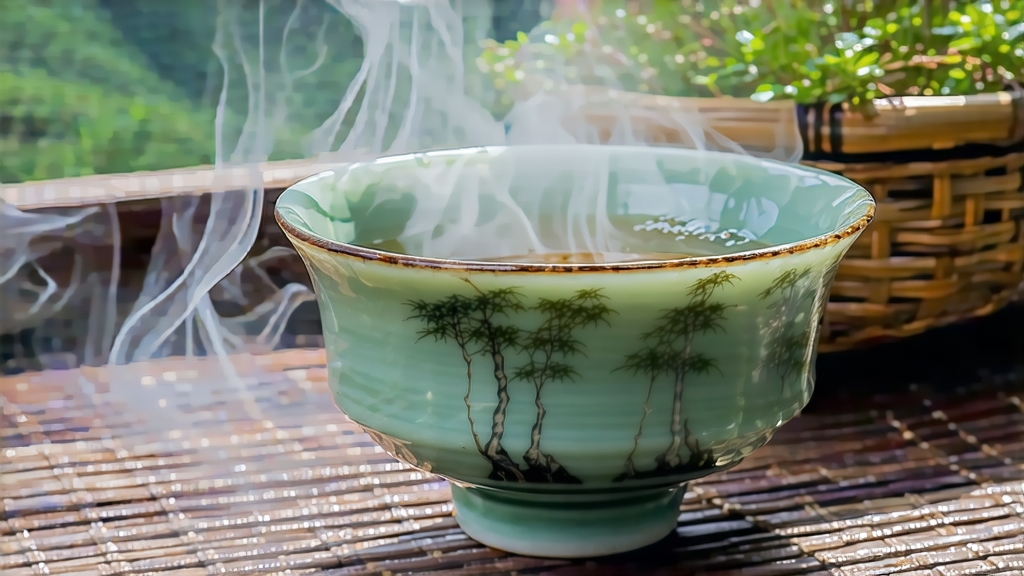
Meng Ding Huang Ya, literally “Yellow Bud from the Summit of Meng,” is the least exported yet most aristocratic of China’s six major tea classes. While green tea commands the world’s attention and pu-erh fills investment portfolios, this yellow bud whispers its story only to those patient enough to listen. Produced exclusively on the mist-capped ridges of Mt. Mengding in Ya’an, Sichuan, it carries fifteen centuries of continuous tribute status, a living fossil of Tang-dynasty court taste. To understand it is to witness how Chinese artisans once slowed time itself, coaxing a green leaf into a mellower, golden incarnation through the almost-lost art of “men huang”—a micro-fermentation conducted in the bamboo belly of a mountain night.
History: From Sage to Sovereign
Legend places the first planting in 53 BCE by Wu Lizhen, a Daoist hermit who transplanted wild tea trees onto the 1,450 m summit, declaring the site “the fairy terrace where immortals brew clouds.” By the Tang dynasty (618-907) the leaf had become an imperial tax paid in tea instead of silver; Song emperors further elevated Meng Ding teas to “First among the Ten Famous Teas.” Caravans of the Ming-era “Tea-Horse Road” bartered Huang Ya for Tibetan warhorses, embedding the bud in geopolitics. When Qing courtiers finally codified the six-color tea system in 1727, Meng Ding Huang Ya was already the benchmark against which all yellow teas were judged.
Micro-Terroir: Where Clouds Touch Soil
Mt. Mengding enjoys a unique three-climate stack: subtropical valley air rises, meets the cold Himalayan plateau wind, and folds back as perpetual fog. The result is 220 fog-bound days per year, 85 % humidity, and a UV-filtered amber light that forces the tea bush to synthesize more theanine and fewer bitter catechins. Soils are Devonian sandstone rich in selenium and zinc, drained by ancient irrigation channels built by Wu Lizhen still functioning today. Only the cultivar “Meng Ding Qunti Zhong,” a seed-propagated landrace with purple-veined spring shoots, is considered authentic; clonal hybrids are rejected by guild regulation.
Harvest Calendar: One Dawn, One Standard
Plucking begins on the first day after Qingming when the morning dew weighs exactly 0.3 g per bud—an empirical threshold passed down by bamboo-weighing masters. Workers wear cotton gloves to avoid hand-oil contamination and snap only the “single bud just unfurling,” 15 mm in length, 0.18 g in weight. A full kilogram of finished Huang Ya requires 42,000 such buds, all picked between 5:30 and 9:00 a.m. while the mountain temperature hovers at 12 °C. Any later, enzymatic activity accelerates beyond the control of the men huang step.
Craft: The Secret of Sleeping Bamboo
The hallmark of yellow tea is the “sealed yellowing” phase, yet Meng Ding Huang Ya refines this into choreography.
- Kill-Green at 140 °C for 3.5 minutes in a shallow 60 cm diameter iron wok, flipping 48 times per minute to preserve bud integrity.
- Initial Roll at 38 °C under 6 N pressure for 8 minutes; the leaf surface cracks but bud tip remains unbroken.
- First Drying on horse-hair sieves above a charcoal basin at 65 °C until moisture drops to 20 %.
- Men Huang: the wrapped dream. Buds are piled 3 cm thick inside freshly split bamboo cylinders lined with lotus leaves. The cylinders rest in a dark, 28 °C, 75 % RH cave for 36 hours. During this nap the leaf chlorophyll oxidizes to pheophytin, catechins dimerize into theaflavins, and a lotus-cucumber aroma emerges. Masters listen for a subtle “pop” every 7 minutes—gas released from non-enzymatic browning—to judge readiness.
- Second Drying at 50 °C for 90 minutes reduces moisture to 7 %, then a final 60 °C bake for 20 minutes sets the golden hue. The finished tea looks like slender pine